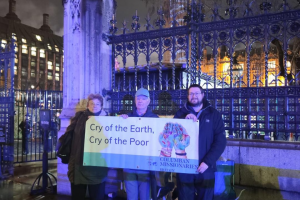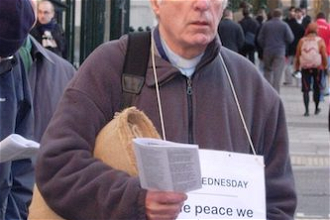South Korea: No naval base on Jeju

Today, 20 September, is the feast of the Martyrs of Korea. Their most important shrine is on Jeju Island, which was a sacred island long before the arrival of Christianity. Fr Kevin O'Neill writes about the struggle to prevent the US Navy from building a navy base on Jeju, wrecking the eco system, destroying the historic sites and displacing the community.
It was one of the most unusual Masses I have experienced, and one of the most meaningful. The Eucharist was held in a small tent across from the main entrance of a construction site, concelebrating priests sat on plastic chairs blocking the gates to the site.
During the Mass police working in threes hoisted each chair and occupant to one side whenever trucks entered and exited the site. It was all done courteously, with the priests and sisters - mostly Korean - holding yellow banners reading 'No Naval Base on Jeju'. Very often it was accompanied by the singing of hymns. Once the vehicles had passed, occupants - including myself - moved our chairs back to our original position in front of the gates.
I was visiting Jeju, situated off the southern coast of Korea in East Asia, specifically the village of Gangjeong to attend the daily Eucharist. The Columban missionaries in Korea are regular visitors, supporting an inspiring nonviolent campaign led by local islanders to stop the construction of a US-backed Korean naval base on an island named the 'Island of Peace' by the Korean government and identified by UNESCO as a World Heritage site. The islanders fear this base is destroying the beautiful ecosystem of the island as well as the majestic soft coral reefs and surrounding ocean life. They also fear the militarisation of their island. The Columbans join Pax Christi International and other Catholic organisations which support the Catholic Bishops' Conference of Korea in its criticism not only of the monstrous construction work but the danger to the region and to the whole world. Jeju lies just 300 miles from mainland China and protestors see the base as a US-driven project aimed at China. The navy base will port US aircraft carriers and Aegis destroyers outfitted with so-called 'missile defense' systems. Protestors fear that, caught between two superpowers, Korea may yet again face the atrocities of war.
The South Korean government denies that the naval base at Jeju is part of US strategic policy that confronts China but, under the terms of its Status of Forces agreement, Washington can deploy its military forces at any South Korean military facility and has already explicitly made known that it is deploying 60 percent of its naval power to the Pacific region as part of it's 'pivot to NE Asia' and its policy of containing China. While there has been no official response from the Chinese government, there have been rumblings that China feels the base could undermine peace and stability in the region. It is clear that the deepwater port being constructed at Gangjeong village is being heavily dredged, being prepared to accommodate multiple nuclear-armed submarines and naval carriers.
Daily Eucharist has been celebrated at the entrance to the base construction site since 2012, when Catholic solidarity with the campaign against the base was officially launched. A small community of Catholics is now located near the base. The community provides a welcome and simple accommodation for those joining the peaceful protest. One Korean diocesan priest has been a part of the community since the Catholic solidarity movement began. There is also a new community of Jesuits in the village. Columban support is based on our society vision of working in solidarity with the poor and the exploited earth, for justice, peace and the integrity of creation.
After the celebration of the Eucharist I joined those gathered for a lovely Korean meal at the make shift community center. I heard that although Pope Francis was unable to make the trip to Gangjeong and meet the villagers during his visit to Korea in August 2014, many took solace from the fact that he made one of his trademark unscheduled stops at the Jesuit Provincial house in Seoul where he commended the members of the Jesuit community in Gangjeong for their witness to peace with the words: "you have accomplished the most challenging duty". For the villagers, the Jesuit community in Gangjoeng, and all the activists, these words showed that the struggle for justice and peace in Gangjeong village are indeed close to the Pope's heart.
Over the meal the villagers shared with me the undemocratic process by which the Korean government chose Gangjeong village as the site for the naval base. As early as 1994 the government was looking for a site on Jeju island, and the villagers of the proposed site strongly resisted. In 2005 the government tried another village where once again there was strong resistance. The third time around, in April 2007, the government took another path, non-democratic this time, meeting only with a very small percentage of the villagers in Gangjeong. On the basis of these discussions, fully knowing that only about 10% of the villagers voiced approval, the government passed the construction of the naval base. The remainder of the villagers heard the news for the first time on TV. They rose up, impeaching the then village mayor and naval base collaborator. Since August 2007 the villagers have been protesting, and this continues although the construction is well underway. The new village mayor has said, "if the villagers have committed any crime, it is the crime of aspiring to pass on their beautiful 400-year-old hometown to their descendants".
Before leaving Gangjeong, Fr Pat Cunningham, who is the Columban Justice, Peace and Integrity of Creation Coordinator in Korea and a regular visitor to the village, took me to the coastline to have a look at the construction site. He showed me where Gureombi rock was once located before it was blasted out of the water in 2012. The rock was a single massive 1.2 km lava rock. Included in the area where the naval base is being constructed is a fresh water coastal wetland, a site of clean fresh water springs, and home to hundreds of plant and animal species, including endangered Red-Foot Crabs, Boreal Digging Frogs, and Jeju Freshwater Shrimp. Korea's last 100 Indo-Pacific Bottle-Nose Dolphins pass closest to land just off the coast where the base is being constructed.
As we left the village we walked past the Jeju diocesan 'Peace and Pastoral Center' which is also under construction. As the daily Eucharist and non-violent protests continue, one could ask - why bother - are not the protests now in vain? The villagers and their supporters feel their struggle for peace, the struggle against the build-up of military arms, including nuclear arms, and the money spent to build and purchase these knowing that this money could be used to aid those who suffer in our world today, needs a strong voice that will endure even when the struggle in one location will not be won.
I left Gangjeong village that day in admiration of the villagers and their brave struggle, and also the peace activists and fellow religious on the ground who are subjected to intimidation, threats and sometimes violence at the hands of the state all in the name of so called 'national security'. In April 2012 a Korean priest was seriously injured while praying at the site of the blasting of the Gureombi rock.
Before leaving Jeju island I met with Bishop Peter Kang of Cheju, the former Chairman of the Korean Bishops Conference. Since 2005, when the base was first seriously considered by the then government, Bishop Kang has been an outspoken critic of its construction, being concerned about the dangerous acceleration of the arms race in East Asia. He addressed the issue of the building of the base at the 2012 meeting of the Federation of Asian Bishops' Conferences and during the visit of Pope Francis last year. The bishop was happy to hear that I visited Gangjeong village. He asked if I saw the diocesan 'Peace and Pastoral Center' saying that the ongoing struggle in the small village of Gangjeong and the new diocesan center are signs and symbols that will keep alive humanity's desire for peace. In past years Bishop Kang has visited Gangjeong in Holy Week, to celebrate the Holy Thursday Eucharist and lead the washing of the feet ceremony at the Gangjeong stream which flows by the base perimeter fence.
The Gangjeong struggle on Jeju brings together all the issues - militarisation, the environment and human rights - that concern Catholics active in promoting the Church's Social Teaching. "Despite the fact that the base will not be rolled back I think this nonviolent campaign is an important symbol for the international peace movement" says Fr Pat Cunningham "and a reminder that this struggle is not just the concern of the people of Gangjeong but one that concerns the global peace community". For me, the Eucharist at Gangjeong took on a whole new meaning, occuring in the context of an act of nonviolent resistance to militarism and a witness to peace and justice.
Fr Kevin O'Neill is the Australian Superior General of the Missionary Society of St Columban with 400 priest members and 55 lay missionaries. He is based in Hong Kong.





















